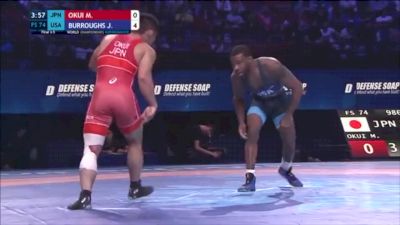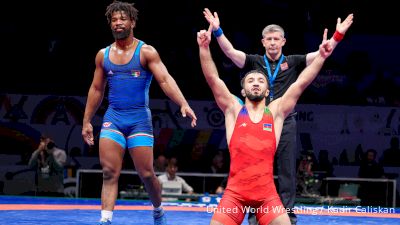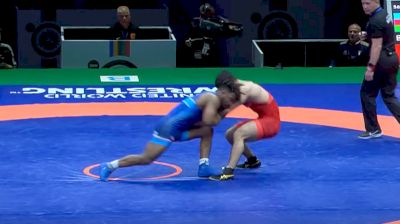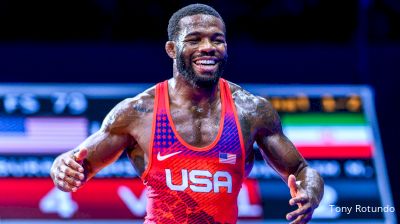How Points Were Scored At 74kgs In The 2019 World Championships
How Points Were Scored At 74kgs In The 2019 World Championships
Mike Mal takes an in-depth look at exactly what set ups and finishes were used to score points at 74kg in Nur Sultan.

Unlock this article, live events, and more with a subscription!
Already a subscriber? Log In
Who, What, When and How Are Points Being Scored At 74kg: Part 2
It's worth repeating: My goal is to run through the 2019 World Championships in its entirety and see who, what, how, and when points are scored at the highest level of the sport. I’m going to start with the most meaningful rounds of the tournament: the quarters, semis, repechage, and medal rounds. This will give me the ability to look at how trends present themselves in different weight classes. Once I get a good collection of data from each weight class, I’ll go back and add in the round of 16, round of 32, and the qualification round. The questions that I hope to answer in this series are as follows:
- What - What tech and what position is scoring the most?
- Who - What athletes from what countries are using which tech to score?
- When - What technique works in what rounds?
- How - Which setups, and which ties are being used to get to the scoring tech, and which finishes are used the most?
While understanding how specific techniques are set up at a particular event is important, the true value will be in comparing the data that we collect with other weight classes and other years. So if I refer back to the info collected last week surrounding 57kg "hows" you’ll have to forgive me, it’s the only data that I have to go on so far.
Let’s get into the setups and finishes that scored at 74kg in the 2019 World Championships.
Setups
Head Inside Singles
As expected, the guys at 74kg aren’t as speed-dependent as the lightest weight class. If you remember correctly, half of the head inside singles that scored at 57kg came from long-range tie ups (If you're confused as to what I mean by long-range tie-ups refer to this vid). The 74kg athletes seemed to vary in the way that they set the technique up. The only reoccurring set up to a head inside single was getting to a collar and ankle (or ankle pick), the rest are in the table below.
Head Outside Singles
Interestingly, the number of points scored on head outside singles (eight) is way down compared to the 24 points scored from that attack by 57kg athletes. Here's how the athletes set them up.
- Sidakov (RUS) set up a head outside low single from an overtie and a wrist.
- Rybicki (POL) hit an outside step from space by using a swim move to get in.
- Okui (JPN) snapped down Rybicki to go to penetration step Hi-C in the same repechage match.
Doubles
Although Jordan Burroughs has been known around the world for his double leg since he won his first world title in 2011, many experts have made mention of the fact that JB has added to his offensive game. Sighting ankle picks and turning many of those doubles into singles. While that may have been the case in the years leading up to 2019 it seems that the double was back in full effect in Our Sultan.
Most of JB’s doubles came from space by circling and waiting for the opponent to square his feet. The beauty in this setup is in its simplicity, but the amount of timing and toughness that it takes to be able to pull that off is otherworldly. Take a look at just how easily Burroughs scores on his double.

The finish is a product of waiting until his opponent’s feet are square and then being tough enough to drive his head right through Okui’s head and hands. Like I said . . . otherworldly.
Here are the rest of the numbers on doubles.
- 4 of the 5 double legs that scored in the meaningful rounds in 2019 were scored by Jordan Burroughs; the other 1 was a sweep double by Chamizo in the quarterfinals.
- 4 out of the 5 doubles that scored came from long-range ties: 3 from space, and 1 from finger ties.
- 1 of the doubles was scored by JB after clubbing the Azeri wrestler in the head in the quarterfinal.
Finishes
Reaffirming my hunch that finishing on the mat is more of a lightweight trend is one of the products of this exercise. Take a look at the numbers associated with finishes.
Head Inside Singles
- 3 of the 9 head inside singles were finished on the mat.
- 1 of those three was finished by going out the back door; the other 2 were finished by running the corner and going backside double.
- 6 of the 9 head inside singles were finished by bringing the leg up off the mat.
- 4 of those 6 finishes were brought up under the armpit.
- 1 of the 6 standing finishes lifted from the crotch, and the last 1 was JB doubling off.
Head Outside Finishes
- All 3 of the head outside finishes were brought up off the mat.
- 1 of the 3 was finished by bringing one leg up under the armpit.
- 2 of the 3 were finished to doubles.
- 1 of those 2 doubles was finished to danger for four points.
Doubles
- All the JB doubles (4 of the 5 doubles scored in the meaningful rounds) were finished in a power position of running your feet.
- Chamizo dusted Kaisanov (KAZ) on that sweep double so much that all he had to do was circle behind.
What Have We Learned So Far?
- Head inside singles score at a higher rate at 74kg than head outside singles. I’m not sure if this is an outlier due to the field Burroughs best attack is a double and Sidakov’s is best when he’s attacking the upper half of the body) or if it is a trend that we will find as we look at other middle and upper weights.
- More standing finishes = more points. There were definitely more 4 pointers per attempt at 74kg vs at 57kg. That result is probably correlated to the fact that almost all of the shots were finished from a standing position.
- If you think that JB has lost a step on his double you’re outside of your ______ mind.
Related Content
 UWW Suspends Officials Involved In Chamizo - Bayramov Bout
UWW Suspends Officials Involved In Chamizo - Bayramov BoutApr 23, 2024
 Will Jordan Burroughs Make His Final Olympic Team?
Will Jordan Burroughs Make His Final Olympic Team?Apr 18, 2024
 Every Jordan Burroughs Worlds Medal Match On FloWrestling
Every Jordan Burroughs Worlds Medal Match On FloWrestlingApr 15, 2024
 The College Fan Guide To USA Wrestling's 2024 Olympic Team Trials
The College Fan Guide To USA Wrestling's 2024 Olympic Team TrialsApr 15, 2024
 2024 Olympic Wrestling Trials Preview & Predictions: Men's Freestyle 74kg
2024 Olympic Wrestling Trials Preview & Predictions: Men's Freestyle 74kgApr 14, 2024
 74 kg Semifinal - Frank Chamizo, ITA vs Turan Bayramov, AZE
74 kg Semifinal - Frank Chamizo, ITA vs Turan Bayramov, AZEApr 7, 2024
 David Taylor Still Really Wants To Fight Jordan Burroughs In MMA
David Taylor Still Really Wants To Fight Jordan Burroughs In MMANov 8, 2023
 Burroughs, Yianni, & McKenna's Results At The 2023 Kunayev In Kazakhstan
Burroughs, Yianni, & McKenna's Results At The 2023 Kunayev In KazakhstanNov 5, 2023
 Jordan Burroughs Passes 1st International Test At 74 kg
Jordan Burroughs Passes 1st International Test At 74 kgNov 4, 2023